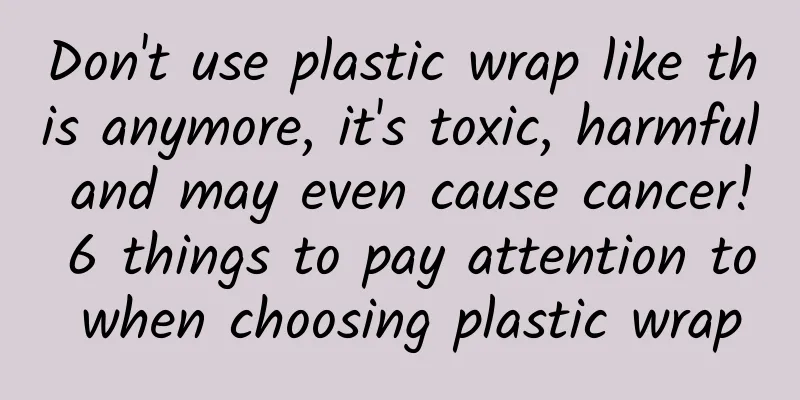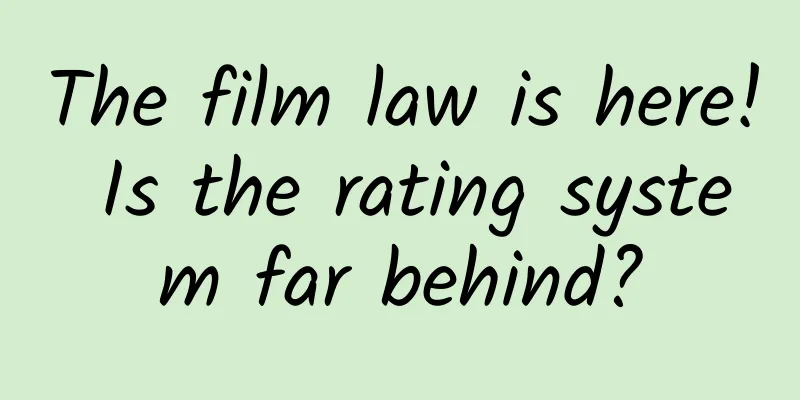Don't use plastic wrap like this anymore, it's toxic, harmful and may even cause cancer! 6 things to pay attention to when choosing plastic wrap

|
In daily life, we often use plastic wrap to wrap food, mainly to cover the openings of food containers, thereby reducing the contact between oxygen in the air and food, delaying the oxidation and spoilage process of food, and maintaining the moisture and freshness of food. However, if the cling film is not used correctly, it will cause many harms to human health. For example, not all cling films can be heated. Some cling films may produce toxic and harmful substances or even carcinogens when heated. So, how to distinguish whether cling film can be heated? How to choose cling film? Today's article will explain it clearly. Cling film commonly used to wrap food in the home (Source: AI generated by the author) What types of plastic wrap are there? Cling film looks soft and transparent, but they are made of different materials. They are usually made of the following plastic materials: Polyethylene (PE): This is one of the most commonly used cling film materials and is widely used due to its safety and low cost. Polyethylene cling film has good air permeability, but its thermal stability and tensile resistance are relatively weak. Polyvinyl chloride (PVC): Early cling film mostly used PVC material. This kind of cling film has high transparency and good ductility, but due to the plasticizers it may contain, its safety has attracted attention, especially at high temperatures or when in contact with oily foods. Cling film commonly used to wrap food in the home | Copyright library pictures, reprinting and using may cause copyright disputes Polyvinylidene chloride (PVDC): This material has good barrier properties for cling film, but is relatively less used due to its high cost and environmental impact. Other biodegradable materials: With the improvement of environmental awareness, some cling films have begun to adopt bio-based or biodegradable materials, such as polylactic acid (PLA). How to distinguish between heatable/non-heatable cling film? When heating food wrapped in plastic wrap at home, can you put the plastic wrap inside and heat it together? You can refer to the following analysis: (1) Polyethylene (PE): This is a common cling film on the market. Cling film made of this material can generally be heated in a microwave oven. However, when heated for a long time at a temperature exceeding 110°C, it will melt. Therefore, it is recommended not to put food wrapped in this type of cling film in the microwave for a long time, or to heat it at ultra-high temperatures for a long time. (2) Polyvinyl chloride (PVC): The cling film made of this material contains plasticizers, which may release harmful substances at high temperatures and is not recommended for heating. (3) Polyvinylidene chloride (PVDC): This type of plastic wrap has excellent performance and can withstand high temperatures of 140°C to 180°C. It can be used for heating, but it is recommended not to heat it in a high-temperature oven. In addition, you can also check the label or packaging instructions. Some manufacturers usually indicate on the packaging of plastic wrap whether it can be used for heating. If the plastic wrap purchased from a regular channel clearly states that it can be used for microwave heating, then this plastic wrap is generally safe. Does plastic wrap contain carcinogenic plasticizers? When it comes to cling film, people may think of carcinogenic "plasticizers". PVC cling film containing DEHP plasticizer does have certain risks, but there is no need to worry too much about other categories. Phthalate esters (PAEs) are a general term for a class of plasticizer chemicals. In the large family of PEAs, di(2-ethylhexyl) phthalate (DEHP) is one of the commonly used compounds. It is often used in the production of polyvinyl chloride (PVC) products, such as medical devices, toys, packaging materials, etc. DEHP may migrate out during the heating process, thus posing a threat to human health, such as interfering with the human hormone system, causing endocrine disorders, and even causing birth defects or other reproductive damage. However, the concentration of DEHP that humans are exposed to on a daily basis is usually much lower than the dose that may cause these health problems. In addition, current studies have shown that the potential effects of DEHA on animal reproduction and development are also limited. Most of these studies were conducted at concentrations much higher than the exposure in daily life. Therefore, as long as the use of DEHP meets the relevant requirements and is used reasonably, there is no need to worry too much. What needs to be noted is that everyone must purchase plastic wrap products through formal channels, and do not buy substandard products because of greed for small bargains. In addition, it is worth mentioning that in order to solve the toxicity problem of DEHP, people have also developed a variety of substitutes, such as dibutyl phthalate (DBP) and benzyl butyl phthalate (BBP). Although these substitutes also have certain safety hazards, they are relatively safer. If you are very worried about the health risks of PVC cling film containing DEHP, you can also choose cling film made of other safer materials. Plasticizers in plastic wrap can easily enter high-fat foods (Source: AI generated by the author) Plastic wrap leaking oil? Will the fat from food dissolve plastic wrap? Some people are curious about the fact that sometimes the surface of the plastic wrap has a lot of oil seeping out. Is it because the fat in the food has dissolved the plastic wrap? In fact, it is not. The plastic wrap is a polymer material, which is made up of ethylene molecules polymerized one by one. There are gaps between the molecules of the polymer material, and the "oil molecules" in the food can pass through these gaps, resulting in oil seepage. The HDPE plastic wrap has small molecular gaps and is not easy to seep oil; LDPE has relatively large gaps and is easy to seep oil. This is why your hands will get greasy even if you wear gloves when eating crayfish. Wearing disposable gloves to eat crayfish will also leak oil (Source: AI generated by the author) Some netizens may wonder, why is low-density polyethylene impermeable? Low-density polyethylene plastic wrap is highly hydrophobic, and liquid water cannot wet the pore walls between molecules, and cannot form a continuous liquid flow, and will not allow water to pass through in liquid form (water vapor can pass through). If you find that the plastic wrap used to wrap food has leaked oil, can you still eat the food? If you don't consider the influence of temperature, the oil will only leak out of the plastic wrap and will not dissolve it. There is no need to worry about eating the "liquid plastic wrap". Tips and precautions for selecting and using plastic wrap (1) Check the material type: Polyethylene (PE): Generally considered a relatively safe choice for everyday use. Polyvinyl chloride (PVC): May contain plasticizers and is recommended to avoid use in food packaging. Polyvinylidene chloride (PVDC): has better barrier properties, but the cost is higher and the environmental impact also needs to be considered. (2) Check the product label: Check whether there is a food safety mark on the packaging and whether it indicates that it can be heated in a microwave oven. (3) Transparency and stickiness: A good plastic wrap should have good transparency and appropriate stickiness so that it can be easily attached to food containers. (4) High temperature use: Follow the instructions on the package, especially those regarding whether it can be heated. Do not use plastic wrap that is not suitable for heating at high temperatures, such as in a microwave. (5) Avoid direct contact with high-fat foods: Some types of plastic wrap will "leak oil" when in contact with high-fat foods and may release chemicals. (6) In addition, most of the common cling films are made of PE, but not all cling films marked with PE, high-density polyethylene (HDPE), or low-density polyethylene (LDPE) can be used to wrap food. You must pay attention to the words "food only", "food safety license" or "QS" before you can use them to hold food. Common plastic bags for garbage are also made of PE, so don't use them to hold food! Generally speaking, cling films that cannot be used to wrap food often have excessive plasticizers and contain harmful substances such as DEHP. The above is the relevant knowledge about plastic wrap. When choosing plastic wrap, it is important to pay attention to the type and safety of the material and avoid choosing products containing harmful chemicals. When using it, follow the safety guidelines, especially the instructions on heating. At the same time, consider environmental factors and choose reusable or biodegradable alternatives to reduce environmental impact. By following these points, you can usually ensure the safety of food while reducing potential harm to health and the environment. Planning and production This article is a work of Science Popularization China-Starry Sky Project Produced by: Science Popularization Department of China Association for Science and Technology Producer|China Science and Technology Press Co., Ltd., Beijing Zhongke Xinghe Culture Media Co., Ltd. Author: Denovo Science Team Review丨Liu Lu Professor and doctoral supervisor at the School of Chemistry and Molecular Engineering, East China Normal University Ruan Guangfeng, Deputy Director of Kexin Food and Health Information Exchange Center Planning丨Zhong Yanping Editor: He Tong Proofread by Xu Lailinlin |
>>: It’s already 2025, why aren’t self-driving cars close to every household? !
Recommend
"Dry Goods" Complete Guide to Internet Finance New Media Marketing Plan!
New media is a relative concept. There will alway...
iOS 11.3 supports importing medical records, which will lead to a medical revolution
Just imagine how convenient it would be if every ...
In-depth analysis: How many years will the popular internet celebrity brands remain popular?
The word "Internet celebrity" has been ...
Baidu did three things right in its transformation to mobile Internet
Since the third quarter of 2014, Baidu's mobi...
Programmers: How to protect your eyes
[[142325]] In three months, I will be a programme...
My clothes have white spots after washing. What else can I do except buy another one?
In daily life, convenient and easy-to-use laundry...
Xiaohongshu operation plan: A guide to attracting traffic from WeChat private domain from 0 to 1
I was communicating with a student the afternoon ...
It’s the season for picking wild vegetables again. How do you tell whether they are edible?
The good times of “everyone digs with a hoe” have...
The number of infected people has exceeded 1,000! The latest report from this place
The latest data released by the Anhui Provincial ...
How to build a brand from 0 to 1?
I often encounter this problem in my daily work. ...
Why do some landing pages make you want to buy after seeing them?
What’s changing in digital advertising ? What is ...
Why is “lazy editing” becoming more and more popular?
The popularity of Tik Tok and Vlog, coupled with ...
Behind the hot capital market of CATL: net profit growth rate increased from 1609.94% to 35.98%
Recently, every step of CATL (300750) in the capi...
China Automobile Dealers Association: In-depth analysis of the national used car market in April 2024
1. Market Overview in April 2024 Monthly transact...
The founder of YC tells you how to raise funds in more than 10,000 words
[[153077]] Paul Graham (famous programmer, ventur...









